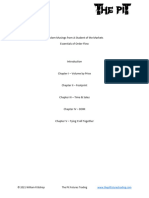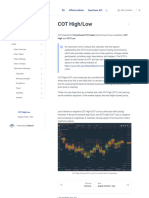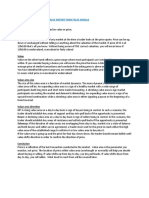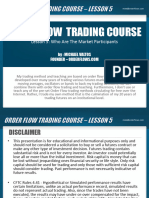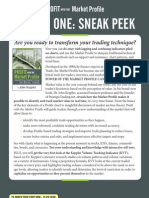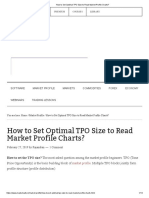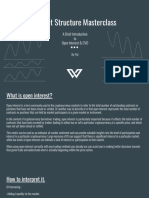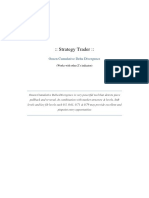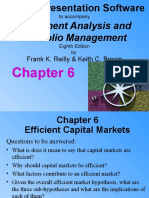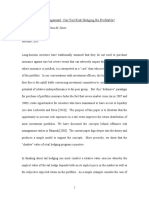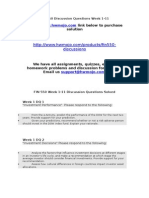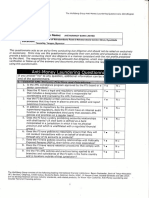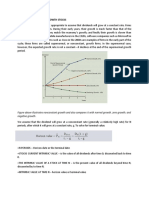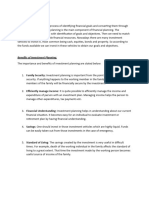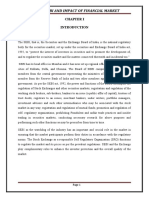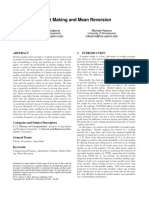ORDER FLOW ENTRIES
USING FOOTPRINT CHARTS
Mastering Market Dynamics for Precision Trading
www.thebankersclub.co.uk 01
� Content
Introduction to Order Flow 01
What are Footprint Charts? 02
Benefits of Footprint Charts 03
Core Concepts of Order Flow Trading 04
Identifying Entry Points Using Footprint Charts 05
Types of Order Flow Entries 06
Advanced Order Flow Strategies 07
Risk Management in Order Flow Trading 08
Case Studies: Real-Life Examples of Order Flow Entries 09
Conclusion 10
www.thebankersclub.co.uk 02
� Introduction to —
Order Flow
Order flow analysis provides a granular view of the market's
buying and selling pressure, giving traders the tools to
understand market dynamics beyond the price movements of
technical indicators.
WHAT IS ORDER FLOW?
Order flow refers to the actual buy and sell
orders in the market. It shows the real demand
and supply based on the interaction between
buyers and sellers. The key to mastering order
flow lies in understanding how large market
participants are positioning themselves and
reacting to specific price levels.
IMPORTANCE OF ORDER FLOW
Traditional technical indicators lag behind
price action, while order flow provides real-
time insight into market liquidity. Traders can
observe the aggressiveness or hesitance of
buyers and sellers in real-time, allowing for
precise trade entries and exits.
www.thebankersclub.co.uk 03
� What are Footprint
Charts? —
Footprint charts provide a visual representation of the
volume traded at specific price levels. Unlike traditional
candlestick charts, which only show open, high, low, and
close prices, footprint charts detail how much volume was
traded on the bid or ask side at each price level.
TYPES OF FOOTPRINT CHARTS
Volume Footprint: Displays the total traded
volume at each price level.
Delta Footprint: Shows the difference between
aggressive buy and sell market orders, helping to
identify buyer or seller dominance.
Bid/Ask Footprint: This displays the number of
contracts executed at the bid and ask prices,
providing a detailed view of the market order
flow.
www.thebankersclub.co.uk 04
� Benefits of Footprint
Charts —
Footprint charts offer several key advantages:
Precision: They help identify the exact price levels
where buyers or sellers dominate.
Transparency: Provides clear insight into volume and
price movements.
Real-Time Market Sentiment: Reveals who is in control
of the market at any given moment.
www.thebankersclub.co.uk 05
� Core Concepts of Order
Flow Trading —
To successfully trade using order flow, understanding key
concepts is essential. Here are the most important ones:
LIQUIDITY, VOLUME, AND VOLATILITY
Liquidity refers to the availability of buy and
sell orders at various price levels. Higher
liquidity, markets offer tighter spreads and
smoother price movement. Volume reflects
the number of transactions happening,
while volatility measures the pace of price
change.
BID/ASK IMBALANCE
A imbalance occurs when there is a disparity
between buying and selling interest at
specific price levels. For instance, if there
are significantly more buyers than sellers at
a price level, it indicates potential support.
www.thebankersclub.co.uk 06
� ABSORPTION VS. AGGRESSION
ABSORPTION: When large buy or sell orders
are absorbed by the opposite side, it can
indicate price rejection or potential reversals.
AGGRESSION: When buyers or sellers
aggressively lift the offers (buy) or hit the
bids (sell), it can signal strong market
momentum.
DELTA DIVERGENCE
Delta divergence occurs when the price is
moving in one direction, but the delta (net
aggressive buying/selling) suggests the
opposite. This often signals a pending
reversal or exhaustion.
www.thebankersclub.co.uk 07
� Identifying Entry
Points Using Footprint
Charts —
Footprint charts help traders identify high-probability entry
points by displaying key order flow patterns. Key patterns
and formations.
KEY PATTERNS AND FORMATIONS
Imbalance Clusters: When aggressive buyers or
sellers dominate at a price level, it can signal
potential areas of support or resistance.
Absorption Levels: If a price level sees high volume
but the price doesn't move beyond it, it indicates
absorption and potential reversal.
Imbalance Clusters: When aggressive buyers or
sellers dominate at a price level, it can signal
potential areas of support or resistance.
www.thebankersclub.co.uk 08
� Types of Order Flow
Entries —
Different types of order flow entries can be used depending
on market conditions:
Reversal Entries
Look for areas of high absorption followed by a shift in
delta or imbalance. If buyers are absorbed at a resistance
level, a short entry could be taken as the price reverses.
Breakout Entries
When a price breaks out of a range, look for a bid/ask
imbalance or aggressive volume to confirm the breakout.
Trend Continuation Entries
In a trending market, wait for a pullback and observe the
footprint chart. A continuation entry can be made when the
delta confirms aggressive buying or selling resuming.
Scalping Entries
Scalpers can use smaller time frames (1-minute, 5-minute)
to enter and exit trades based on short-term volume
imbalances.
www.thebankersclub.co.uk 09
� Advanced Order Flow
Strategies —
For traders looking to refine their order flow skills, combining
footprint charts with other advanced tools can improve
accuracy:
Market Profile & Footprint Charts: Market profile
charts organize price action based on time spent at
each price level. They can be used in conjunction with
footprint charts to spot key areas of value.
DELTA DIVERGENCE STRATEGY: When delta shows
strong buying but the price fails to rise, it could
indicate weakness in the trend, signaling a possible
short trade.
VWAP and Order Flow: Volume-Weighted Average
Price (VWAP) can serve as a dynamic
support/resistance level. Using footprint charts to
observe volume reactions around VWAP helps confirm
entry points.
www.thebankersclub.co.uk 10
� Risk Management in
Order Flow Trading —
Effective risk management is crucial in order flow trading.
Here are some methods:
Stop-Loss Placement
Use the footprint chart to place stop-losses below
significant support or resistance levels where high-
volume absorption occurred.
Position Sizing
Determine the risk per trade based on the size of
imbalances or volume clusters.
Managing Emotions
Order flow trading is fast-paced. Stay disciplined with
your strategy, avoid impulsive decisions, and follow
your trade plan.
www.thebankersclub.co.uk 11
� Case Studies: Real-Life
Examples of Order
Flow Entries —
Below are examples of the most basic classic order
flow setups that you can use to understand how we can
interpret the order flow and what kind of things to look
for when we are approaching a point of interest on your
charts.
The basic things we look for are:
Increase in volume
Heavy buying/selling into the area
Rejection in the form of a tail
Increase in Delta in the new desired
direction
Stacked imbalances
www.thebankersclub.co.uk 12
� If you are interested in getting our in-depth video
course and mentorship where you will learn all the
advanced order flow techniques that will allow you
to know when to enter the market with precision,
visit the website link below:
www.thebankersclub.co.uk
www.thebankersclub.co.uk 13
� Below is an example of a valid order flow footprint
setup at a point of interest.
I’ve used the standard retail candlestick chart as a
supply zone area, and also the more informative
market profile charts as an example of the point of
interest area. So whatever the strategy being used,
footprint can validate the zone.
www.thebankersclub.co.uk 14
� London Open Liquidity Grab
In the example below, we again see that an increase in
volume into the POC, large numbers of buy-side delta, and
rejection selling tails leads to a massive shift in order flow
to the sell side. There was a pullback, so if you didn’t get
in on the first aggressive short opportunity, then on the
pullback, you could find another opportunity.
www.thebankersclub.co.uk 15
�www.thebankersclub.co.uk 16
� Custom afternoon profile...
price opened and auctioned up to value & rejected from there. if you were just looking at
standard daily profile you would not spot this opportunity. We can then see on footprint high
volume and buyside delta into the value area, followed by instant rejection as sellers stepped
in aggressively (pintail showes this easily) along with high selbside delta, next candle
decreasing volume and continued high sellside delta, next candle showed buyers trying to
push price but failing miserably (another pintail) buyers exhausted, sellers then took control
and market has sold off for about 50 pips
In the below example we have a rejection from custom
afternoon POC level. a lot of sell side delta coming right
into the area of interest. Followed by the volume increase,
then rejection where sellers stepped in aggressively,
shown by the selling tail. Complete lack of interest from
buyers thereafter and market auctioned lower.
www.thebankersclub.co.uk 17
�In the below example, we see a stop run scenario..
Consolidation for a period of time. When we see that, we
can anticipate an explosive movement.
Then a significant increase in volume and sell side delta
into the point of interest, (excess on vol profile) we then
saw sustained sell side delta dominating but price closing
higher on the candle.
Nice clue, we could be looking to go higher. Buyers then
stepped in. Could have had an aggressive entry and exited
at first point of resistance.
www.thebankersclub.co.uk 18
�We then see a pull back towards reversal and into a area
of imbalance (highlighted by my study in purple) here any
traders in that earlier sell side candle that closed higher
(who would have been drawn down) would now be at
break even and most likely would exit their trade.
This fuels the fire, buyers then also add to/step in again as
we see with buy side delta, and price auctions higher.
Tricky setup that one to read, but I’ve seen similar happen
over and over. With time, your eyes will train to see and
interpret similar setups when they occur.
www.thebankersclub.co.uk 19
�In the below example, we can see again price holding just
before a point of interest being a weekly TPO LOW VOL
NODE. And an area of stand alone stacked imbalance on
foot print.
Loads of buyers pushed price into the point of interest,
followed by a big responsive selling tail on the 5 minute
candle, with a very high amount of volume and sell side
delta. This is why I like to have the high low vol nodes set
on my weekly chart, they can be helpful in finding possible
areas we may see area action. And then obviously the foot
print helped seeing the transition from buyers to sellers.
www.thebankersclub.co.uk 20
� Below example of classic stop run on the foot
print - passive buyers got triggered at a custom
morning chart value area.
www.thebankersclub.co.uk 21
�Below is a example of a trade it took and was
spotting stop run on the foot print at a point of
interest, this scenario happens a lot
www.thebankersclub.co.uk 22
�Below examples show a classic stop hunt setup
which was the start of a 80 pip move
www.thebankersclub.co.uk 23
�Below is a video example of a trade it took and
was spotting absorption on the footprint, this
scenario happens a lot.
www.thebankersclub.co.uk 24
�And finally
We also have made software that uses proprietary order
flow calculations and combines the use of volume, delta,
time, and price, in order to help spot automatically where
absorption is taking place indicating the market makers
are active and therefore signaling the potential of a market
reversal. You can see in the image below an example of
this software in action on our charts. Our students have
access to all these tools and use them in helping them
make their trading decisions.
www.thebankersclub.co.uk 25
�And in the image below we can see what the orderflow on
the footprint chart looks like at the areas of where our
absorption indicator triggers, our aim is to make life as
easy as possible for the trader.
www.thebankersclub.co.uk 25
�And again below we can see on gold how the orderflow on
the footprint combined with our absorption trigger chart ,
was a great reason to take a trade from our custom
market profile level. very straightforward confirmations
there.
www.thebankersclub.co.uk 25
�And again following on from the above example, our
absorption chart triggered again to signal another trade
opportunity at the profile chart value low level. and a
glance at the footprint we can see the buyers stepping in.
www.thebankersclub.co.uk 25
� Conclusion —
Hopefully this short book has opened your eyes into
how having access to this little-known institutional tool
can literally provide you with a massive edge in
validating your trades at a point of interest.
Combine this tool with other institutional tools as well
and you have an unfair advantage over the retail crowd.
If you’re interested to learn more about us using these
tools and strategies in your trading, then you can reach
out to us via email below
Darren@clubbanker.co.uk
Or
Enroll in our course and mentorship and get access to
all of our charts, by visiting our website below
https://www.thebankersclub.co.uk
www.thebankersclub.co.uk 26
